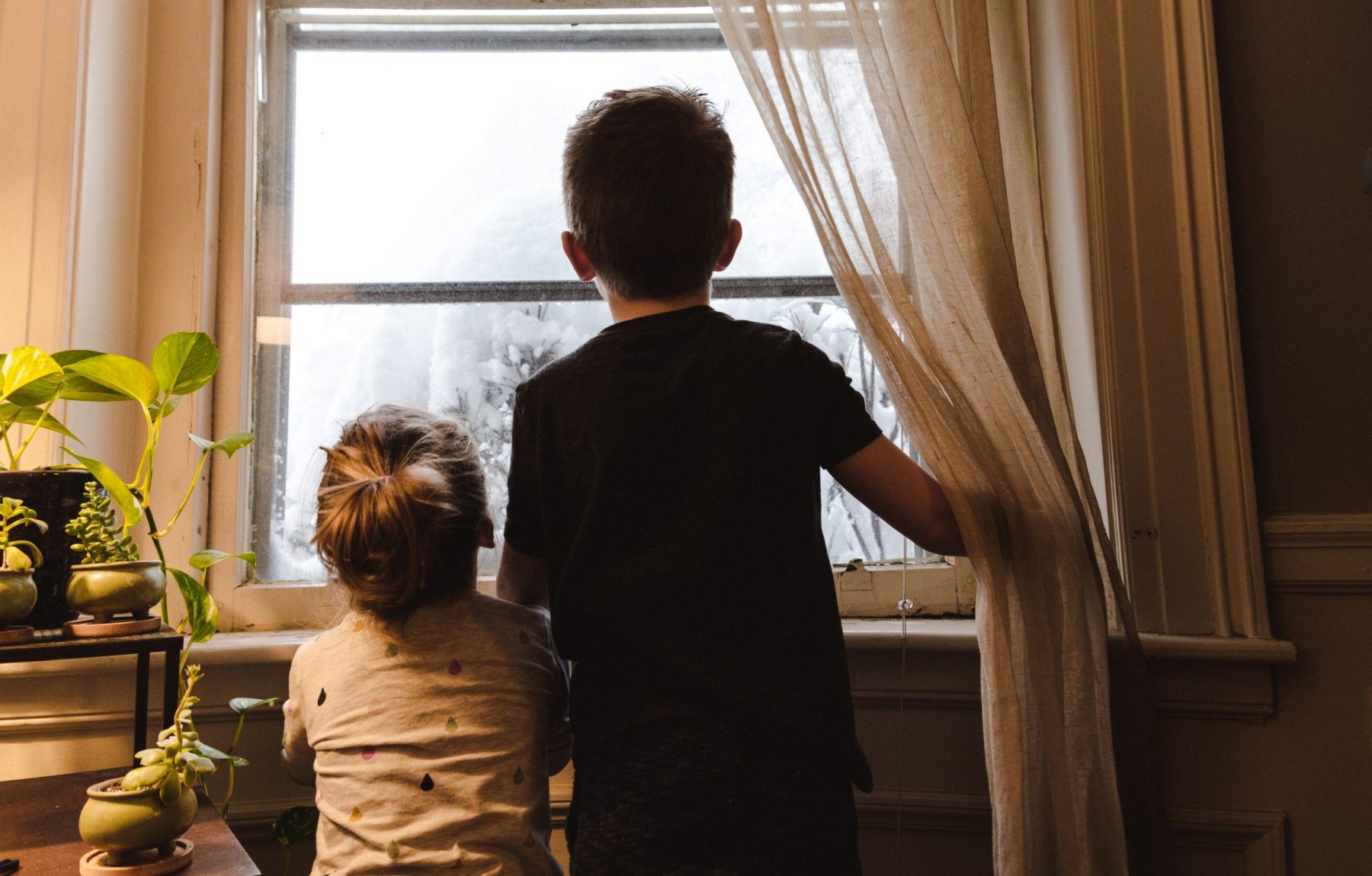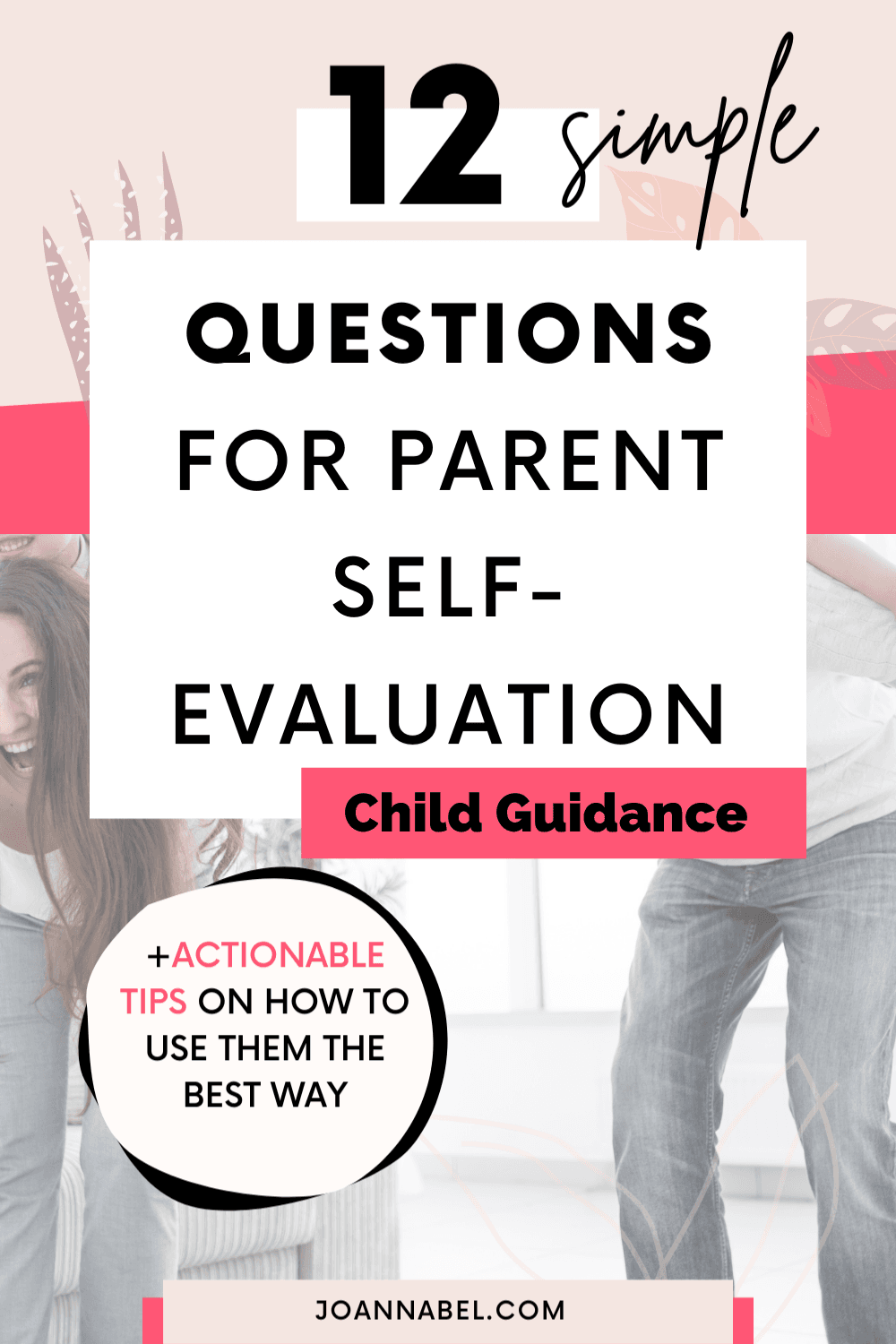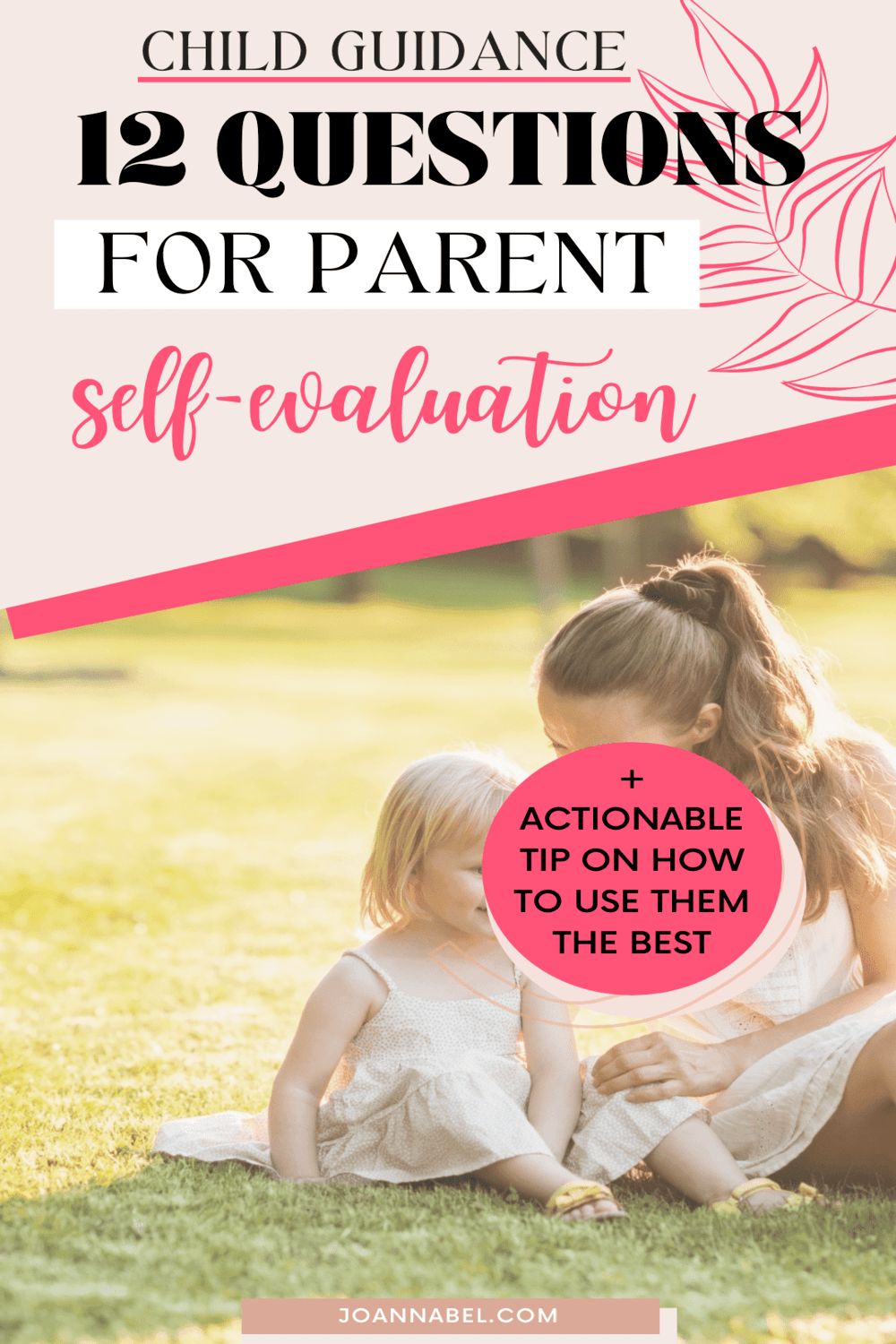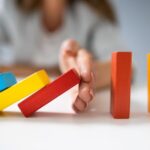Do you think about child guidance often? And sometimes even feel conflicted, because of different messages about child guidance you’re getting nowadays?

Child Guidance
They might not match your point of view or your experiences with being a child yourself.
Maybe you’re even annoyed because there’s exaggeration or contradiction everywhere you turn.
I understand. And I believe this is quite common because I feel it too, even when I’m talking to some of my colleagues who’re also trained in this field!
Well, I also believe there’s no parent in this world who hasn’t, at least once, questioned if they are doing a good job with child guidance.
Guidance and Boundaries refers to parents assisting children to regulate their emotions and behavior, so the child can evolve into an autonomous person and a responsible adult.

The thing is nobody taught parents the best thing to do. Yet, they’re all expecting you’re skilled. The actual truth is that everyone is getting more and more skilled along the way, and implementing what they’ve experienced, learned, or inherited from their parents.
And that’s fine, we’re doing the best we can at this very moment. Thankfully, these days we can find more information in more places. Moreover, it comes down to choosing the best approach to learning for us specifically.
So, if you want to know more about the optimal approach to child guidance, as well as get a proper orientation on your child guidance, I highly recommend you read this post. And use these 12 questions as a resource to get a perspective on where you are now or if there’s an issue, where it lies.
As a bonus, you’ll find an actionable tip at the very end of this blog post to help you take advantage of the questions to the fullest.
What I strongly believe in, is that everything can be balanced out with just a little push towards a more open-minded space.
If you’re aboard, then let’s do this!
And if you like this post SHARE it so more people can see it, or PIN it for later by clicking any image in the post!
Note: Although I am a Clinical Social Worker, engaging with this website does not establish a professional social worker-client relationship. The information provided here is for general purposes only and should not be considered professional advice. While we strive to ensure accuracy and reliability, this content is not a substitute for professional guidance. For specific concerns, issues, or situations, it is essential to consult a qualified professional and present your situation. Read the full Disclaimer here.
WHAT IS GUIDANCE AND WHAT IS THE PURPOSE OF PARENTAL GUIDANCE?

First, let’s think about a few interesting things.
How does the child know where to go? What to do?
How do children learn to define and differ their personality and individuality from others?
How will a child make a difference in its roles and obligations and those of its parents?
How does a child learn how to behave? How to channel emotions?
And what´s appropriate social interaction with others?
How does a child internalize morality sense, moral values, and conscience?
How does a child seize autonomy?
Well, it all comes down to the next parenting capacity dimension (one of the several) referred to as solid guidance and boundaries established. Widely known as child guidance.
Let’s see, Guidance and Boundaries can be easiest explained as parents assisting children to regulate their emotions and behavior, so the child can evolve into an autonomous person and a responsible adult.
So, a parent’s job here is to shape and model ”appropriate” behavior and human interaction, so a child can develop prosocial behavior, internalize a sense of morality and conscience, as well as learn how to control and manage its reactions, emotions, and behavior.

Now, this means, a child will become:
- competent in quality/prosocial/positive interaction with other people,
- more independent,
- and will have crystallized prosocial values.
As a result, children will have learned social skills, which will be used in many different social situations and interpersonal interactions.
With more positive opportunities for children to learn and manage social skills, the level of mastered social skills will be higher.
NOTE: This is a long blog post with a lot of important information and actionable tips, would you like to take it with you? I have created an e-book with additional workbook (printable and fillable) for you so you can get the most out of these guidelines. Workbook has worksheets, goal planner, action planner, daily, weekly and monthly planner. Just click the image below to get it.
So when it comes to this parenting capacity dimension, I must say that if you deal with it sooner than later, you’ll save yourself a lot of headaches.
Regardless, what’s important to emphasize here, is the fact that even behavior considered antisocial, can be changed or unlearned and replaced with a more functional, or prosocial.
However, in certain situations and depending on different factors combined, you might need to consider consulting a professional for support, guidance, and assistance in achieving this.
Even though this dimension bears a lot of responsibility, I invite you to look at it from an optimistic perspective. How so?
Well, deciding to master guidance and boundaries is a sign of love and a sign of bravery!
Why?
Because you are willing to let your child not like you sometimes (or often at some periods). And you’re also willing to endure the pain to watch him or her struggle.
But if you gather enough courage to go for it, your child will love you and be eternally grateful. If you need more details concerning the position of guidance in child development, read my blog post that covers it. Here is the link to What Is Guidance In Child Development.
Now, how is child guidance related to positive parenting?
POSITIVE GUIDANCE AND POSITIVE PARENTING AS PERSONAL DEVELOPMENT GOALS
Positive guidance as a phrase is usually used when someone aims to explore the topic of positive parenting. Now, positive parenting is not exactly a synonym for proper guidance (and boundaries) establishing, we are talking about.
Proper guidance and boundaries are just an integral part of positive parenting.
So positive parenting is parental behavior shaped by the child’s best interest (a term from the UN Convention on the Rights of the Child) and child’s rights, but with being cognizant and considerate of the parent’s position, needs, and resources at the same time.

Firstly, a positive parent is a parental figure who acknowledges children as competent individuals entitled to their rights that can’t be transferred to someone else or alienated.
Secondly, a positive parent leads a child towards achieving full potential while protecting the child from harm and raising them in a safe environment.
But without overprotecting and stopping a child from making its own choices, with respecting evolving autonomy in decision-making and the child’s need for more and more independence as they grow.
Finally, a positive parent is a parent who’s setting the limits for the child to help the child internalize the moral norms, and is shaping prosocial behavior in a child.

So the full potential, we just mentioned, is achieved when parents are:
- Emotionally warm and responsive.
- Supportive.
- Present.
- Set and clear out the rules and expectations.
- Put effort into understanding a child’s behavior, point out and praise good behavior and react to misbehavior in a nonviolent manner.
- Help children integrate their life experiences.
- Focused on reparation over retribution, but if using punishment are fair and righteous and never cruel and harmful.
If you want to learn more about how you can assure your kids reach their full potential, go ahead and check out my article on it, Helping a Child Reach Full Potential – 7 positive parenting tips.
And for those who want to know how to support your child to become more independent, read my blog post How Do You Help Your Child Become More Independent.
In case you need more information on what’s an “appropriate” way to punish a child here’s the link to my post What Is The Best Way To Punish A Child?.
If you want your parenting to be effective, and your children successfully developed, happy and well-adapted, you should set positive parenting as your personal development goal.
So how can you tell if you are doing it right with child guidance? Or how to do it right exactly?
REFLECT ON IMPORTANT YET SIMPLE QUESTIONS TO SHED LIGHT ON YOUR GUIDANCE
The next several questions can help to put guidance from you as a parent in perspective and direct you towards change, if you need it, of course.
They’re not numbered by order of importance, so feel free to focus on the most important ones for you or your situation. Let’s explore them together, so grab a cup of your favorite drink!
Or simply pin this post on Pinterest for later to come back to it.

1. HOW DO YOU STEER AND REGULATE A CHILD’S BEHAVIOR?
First of all, what’s important to say is that regulating and influencing your child’s behavior is obviously the way to go. This means it’s good parenting if we pay attention to it and get involved. Naturally, it’s important to get involved the right way, which means constructively, as opposed to destructively.
This may come as a surprise to you, but not all parents get involved.
In my professional practice, for example, I’ve listened to a testimony of one parent whose husband was sitting with the closed door in one room, uninvolved and silent, while in the other room she was trying to escape her minor son’s glass and telephones breaking, and eventually experiencing a knife being driven into the door after chasing her.
Now, we won’t get into any more details about this extreme example, of course, but what I’m trying to say is that our actions have consequences, and an uninvolved parenting style has them too. If you’re curious about parenting styles, you can read my blog post What Are The Parenting styles: All You Wanted To Know on this topic. Or you want to know more about uninvolved parenting here’s where you’ll find more details: What the Uninvolved Parenting Style Really is and Who Uninvolved Parents are?

So, of course, we do have to get involved in regulating our child’s behavior, while being attentive enough not to over-regulate it, naturally. It might sound like a chore being put like this, but I encourage you to relax.
And the best tip for this is simple – follow your child. But what does it mean?
Well, look at how the child is functioning – if it’s rebellious or resisting most of the time, whether it’s disregarding any intervention, or at the contrary, being too obedient or scared, as well as withdrawn, or maybe even sad or angry. And so on.
What you want to consider always is a child’s age and developmental phase, because some behaviors can be related to this as a factor. Follow your intuition while analyzing, too. Intuition is knowledge.
And of course, ask a child and be open to hearing the answer. Don’t shut the child down, instead, encourage him or her to speak up or open up.
Listen to the feedback you got, and reflect on it carefully. Is there a truth to it? Ask for more feedback from other involved persons and keep an open mind about it all. Don’t fall into guilt – paralyze trap, instead try to find a proactive way to look at it all, and then find a way to make a change you need to make.
Temptations to do things the old way will happen, even relapses are common, but just continue moving forward. You can do it!
So, when it comes to this question, in the shortest, it’s managing to keep positive guidance in managing your child’s behavior. If you want to see the signs of good behavior management read my blog post that explores it.
WHAT IT TAKES
So what it takes is next:
- You’re providing structure and have a balanced attitude around control.
- You’re not over-controlling or overly punishing. Or both.
- You’re consistent with a balanced structure and guidance.
- You’re able to modify your expectations about your child’s behavior.
- You’re not oppressive, patronizing, or over-dominant.
- You’re not a withdrawn or aloof parent.
- You’re modeling proper prosocial behavior, empathy, and balanced expression of emotions.
- You’re balancing rewards and punishment systems.
- You’re familiar with your child’s whereabouts.
- You’re not overprotecting (especially when it comes to preventing a child from their own experience or experience gaining) and overbearing.
- You’re properly reacting if your child is hurting other kids or if somebody is hurting your kid. You’re righteous in these situations. This strengthens your child’s prosocial behavior.
- You’re watching your child´s behavior closely but not intrusively.
Here you have my blog post on this with all of them explored in a more detailed way – Child Behavior Management: 12 Signs You’re Crazy Good at it as a Parent.
If you’d want to find a middle ground in these, let’s say it’s about a balanced attitude around control and discipline you have over yourself and your child.

2. HOW FLEXIBLE AND CLEAR ARE THE BOUNDARIES?
You don’t want rigid and stiff boundaries. This means:
- your child is free enough to approach you
- your child can be optimally close to you – not too close (smothering) and not too far (distant)
- you’re not over-controlling and too pressuring (overbearing)
- you’re aware when you overstep boundaries
- and you respect your child’s boundaries too.
Let’s try to imagine switching positions – where you become the child who needs to move within the rules and limitations you’ve set for your child.
How do you see the boundaries now? Are they flexible enough? Are they vague? Or are they too rigid?
Also, you should be assertive (not aggressive nor passive – making retreat) when your child is opposing you.
This means that you remain determined with your request or demand, but you stay gentle enough to the child. So you want to prevent yelling and this can help with that.
But what you also don´t want, are unclear, blurred, or easily overstepped boundaries. Because then you have an outcome where nobody knows its roles, position, or what to do.
So what a child does (or doesn’t do) and what an adult does (or doesn’t do) should be clear and followed consistently.
Moreover, clear boundaries between the family members – so between the parents and the child too, help the child form a distinctive personality and positively contribute to the child’s mental health.
This happens because a child gets a more clear sense of self. So this way the child understands in what way they’re separated from other persons. And this is very important for any human because it’s a part of the individuation process, or process of reaching a stable, independent personality.
At the same time, the result of this, is a child becoming more and more independent as they grow considering they receive a message that individuation is o.k, having a separate existence is o.k, and a ”private space” is o.k.
So, you need boundaries to be flexible so you can respond properly to a child’s needs. But responding to a child’s needs shouldn’t result in overprotecting or smothering the child. Remember, your ultimate goal is for a child to keep getting more and more independent. Read my blog post about How You Can Help A Child Become More And More Independent, too.
3. HOW FLEXIBLE ARE THE RULES AND EXPECTATIONS AND TO WHAT EXTENT ARE THEY CLARIFIED?
What’s important here is whether the rules and expectations are appropriate for a child’s age and whether they’re too rigid or too lenient, or if you’ve achieved an optimal level of flexibility.
As well as whether your kid knows what the rules and consequences are. Together with your actions that are following what you’re declaring.
Your child shouldn’t feel like his or her life is a chore or even a military camp, but also, no child wants to live without an optimal amount of discipline (positive discipline). So what you need is balanced flexibility.
I always associate positive guidance and positive discipline with love because a parent is willing to feel pretty uncomfortable having to watch a child suffer. By suffer I don’t mean misery, of course. I mean any form of pain we endure while trying to succeed at something. Learning some new skill or something similar.
At the same time, a parent is willing to accept your children might not like you very much at the exact moment you’re pronouncing disciplinary measures.
But your children will love you and thank you for it for the rest of their lives because you’re making a functional person out of them this way.
And what’s even more important, you will thank yourself for it later. Being consistent enough with disciplining them while doing it the right way is a clear sign to them that you love them.

Here are some general guidelines that can help you reflect on your situation or improve it:
- The rules don’t change too much or often.
- The rules are clear and comprehensive enough to follow.
- The rules follow a certain logic, and you put an effort to help a child understand that logic.
- The rules aren’t too strict or smothering.
- Breaking the rules leads to disciplinary measures and parents are consistent with it.
- A child is not expected to take over a parent’s roles and obligations.
- A child shouldn’t be caught in between the parents.
- A child understands what’s expected to do or not to do.
- A child shouldn’t receive conflicting messages about a certain expectation.
- Parents follow each other in general and don’t undermine the authority of each other.
- Parents can have different approaches to a matter, but they should follow the same ground principle.
- Parents can make mistakes with disciplining children (don’t fear this too much), but the problem is if this turns into a pattern through repetition.
Try to evaluate your situation by following these guidelines and tell me what else you see as important in the comments! I’d love to exchange opinions with you.
And if you need more information, you can check out my blog post that covers setting rules for kids the best way. Here it is: How To Set Rules For Kids The Best Way.
4. HOW ARE YOU TEACHING A CHILD TO DEAL WITH FRUSTRATION?
The main focus is on your responding when a child is experiencing frustration. You need to be tolerant enough to uncontrolled emotional expression when it comes to youngest children – rage and anger. And when it comes to older children and youth it can be moody, aggressive, demanding, stressful, etc.
So this means you shouldn’t respond aggressively yourself, since it will only raise the tension.
A better way is to let the frustration be expressed and then manage the attention or direct the child’s attention away from frustration.
So you need to help the child to learn or begin to understand that there is a way not to let frustration be in charge of the behavior.
This means we don’t ignore the frustration which is smothering the child, but we show them how to shift their focus.
What you should avoid is taking a child’s frustration too personally.
If you’re usually responding with: anger, resentment, rejection, ignoring to give support, getting back at them, etc, you are only strengthening the frustration, negative emotions, and a child’s agony.
This means you need to aim for a child’s dealing with frustration, not shut it down or either strengthen it through some unfit practices. This way you set the base for a child to learn how to channel different emotions the best way.
Get the post as a editable pdf with a workbook for going through the practical steps and turn your insights into action.
5. ARE YOU MODELING THE BEHAVIOR YOU EXPECT TO CULTIVATE IN A CHILD?
If you’re telling a child not to do certain things while you’re doing those exact or similar things, that probably won’t work. It’s because your child probably thinks that´s unfair of you.
Children are more sensitive about injustice than grown-ups. Or better said, they are less accustomed to it. The message you’re sending this way is that you’re the privileged one.
So if you expect the child to behave in a certain way, the easiest and fastest thing to do is to model the behavior. This way you won’t even have so much explaining to do.
Your child has learned so many things she/he now knows exactly from you. Kids are listening and watching all the time, too. Be mindful of this.
But don’t obsess about it of course, because we’ll also make mistakes and children should know that.
You don’t want them to be rigorous/rigid about their or other people’s mistakes. Instead, you want them to be able to digest mistakes as part of life and part of being human.
You can find so many adults who spend hours and hours in therapy (it’s amazing that they took this step, of course) because they can’t continue to live a functional life after some of their mistakes. Or they can’t enjoy life or function in life. Because they’re forcing themselves to behave like robots and terrorizing themselves with so many high standards and demands for perfection.
I’m aware this sounds a bit harsh, but it’s the truth.
Kids should learn to integrate mistakes into their lives, and you’re the one that can help them do that. Considering you’re the most important figure that’s leading the process of moral norms internalization, you have an impact on it.
So try to look at it from the outside perspective. And try to understand whether your expectations and demands regarding their behavior could lead to a future problem with perfectionism.
If you’re not sure, consider asking for feedback from someone you believe will be able to answer objectively.
So what you want is to model prosocial behavior, but you want to avoid overly strict moral norms at the same time.
6. DOES YOUR CHILD UNDERSTAND WHY IT’S BEING PUNISHED AND IS LEARNING FROM ITS MISTAKES?
A child needs to understand the process of punishment properly. In general, the child shouldn’t confuse the message ”you did something wrong” with ”you’re disobeying any of my commands” even when they’re appropriate.
So children shouldn’t get the message that the only reason they’re doing something is to please the parent. You’d rather have them doing something because they’ve learned it’s the right thing to do. Your job is to help your child internalize a sense of moral and ”proper” social values.
Of course, a child will want to please you very often. A child wants to be accepted by you. But it’s more important their behavior is shaped in a way that ensures they know how to maintain functional interpersonal relationships and develop social responsibility.
So you need to teach a child how the cause and the consequence are related. A child will learn from their mistakes only if a child understands what was it all about. As well as how to try to make up for it, how to do things differently, say I’m sorry, etc.
A child actually wants to know what is a proper way to behave and you’re the one that needs to guide your child and lead the way! Even when your kids are contradicting you, they still want to know what’s the right way!
Their resistance has a certain inner motivation, you need to ”crack it”. So never give up on positive discipline.
A child doesn’t want to be lost and confused. It´s such a difficult and frightening position to be in!
So, help your child understand what the heck is wrong.
Avoid shutting them down and leaving them only with unaddressed guilt that further may turn into a belief they’re not good enough except they are this and that (always perfectly obedient, perfect at everything, too scared of their, and mistakes of others, and so on).
Make an effort to help them understand more because often we can’t see how it is from their perspective and we forget they know less than it seems so then we falsely declare they’re naughty.
Before you jump to the conclusion of their naughtiness, make sure you’ve done all to help a child understand and know what’s the right way – you also need to consider your beliefs about a child’s position in the family/society.
The commonly rooted belief goes that kids are there to behave and do as we say, so then our irritability or lack of tolerance for their disobedience might be a result of these deeply embedded beliefs and misconceptions.
Just something to keep in mind that can make a process easier if you remember it each time you find yourself annoyed with them.
If you are not sure whether you’re using punishment the right way here’s my blog post that will help: What Is The Best Way To Punish A Child.
And if you need guidelines concerning child behavior management, read my blog post on this topic.
If you found the information on the blog helpful & inspirational and you feel like giving back, you can do it by clicking the donate button after entering amount you’re comfortable with. I’ll use it to create and deliver more useful content and resources like this. Thanks for your precious contribution!
7. ARE THE PUNISHMENTS WEIGHED AGAINST MISTAKES AND APPROPRIATE FOR THE CHILD’S AGE?
As I mentioned at the beginning of this post, positive parenting is focused on reparation (see more about the restorative justice concept) rather than retribution. So this means it’s more focused on repairing the damage than on the punishment for the misbehavior.
This is due to the positive benefits of reparation (material things or relationships), in comparison to retribution which emphasizes the need to equalize things and punish the offender.
While punishing the offender has its purpose, what’s usually forgotten with retribution, are the needs of the subject that got damaged. And in restorative justice, this is the main focus. The offender is held accountable, but the needs of the side that’s injured are at the center because this is the way to make things right.
So I encourage you to think about offenses and punishments from this perspective. So then the good positive guidance techniques could be focused on repairing the damage and responsibility, rather than on harsh mannered punishment or punishment in general.

But here are general guidelines regarding punishment:
- The punishments shouldn’t be overly strict. Instead, they need to fit the mistakes’ importance.
- The punishment can’t be too mild either.
- The punishment should be weighed to the offense.
- A parent should never be cruel or vindictive.
- A parent needs to be consistent and predictable – the child should know what´s coming.
- A parent needs to set limitations because a child needs to know and internalize how to behave now and in the future.
- A parent needs to take responsibility for teaching a child what is socially acceptable behavior.
- A parent shouldn’t overly weaken or destroy the child’s willpower.
- A parent needs to be tolerant of a certain level of disobedience. Don´t confuse a good child with an obedient child.
- And if a child has weak willpower learn how to strengthen it.
- Modeling one behavior and demanding the other doesn’t produce the result you want.
I hope this helped, but to help you even more with this, I’ve created a digital download for you – it’s a 10 Dos and 10 Don’t When Implementing Punishments As A Response To Child Behavior. You can use it both in digital format and as a printable. As soon as you receive your download, you can immediately start using the digital copy.
This digital product will help you:
- clear out what is and what isn’t recommended (or even acceptable) to do in the case of punishment,
- give you guidelines on what is effective and recommended in form of short tips,
- as well as help you take inventory of your punishment system and take action in case to make necessary changes.
Note: This product doesn’t intend to recommend that you use punishment as a disciplinary measure. It’s intended to help you avoid mistakes that can be harmful for children and your relationships with them.
And let’s move to the next question!
8. ARE THE DISCIPLINARY MEASURES CONSISTENT AND EFFECTIVE?
You need to finish up what you’ve put in motion because this teaches a child to be consistent and responsible. Also, this way you show the child you mean it and not to catch curves.
At the same time, the child learns a lesson you’re trying to teach – not to do things a certain way.
If the disciplinary measures you’re using are ineffective, you should analyze if they’re appropriate.
This means you need to know if you’re being too easy or too heavy on the child considering the mistake. Be careful because if you get too heavy then you’ll soon face a lack of options and manoeuvre for the bigger mistakes! This is a slippery field that can go the very wrong way.
Also, you need to analyze if your measures are appropriate by their nature, to begin with. Are you maybe a bit out of line or even vindictive, or cruel? Or are you declaring one thing and then doing the other?
So if you think your child will stay in the house just because you hid its shoes, you need to think twice about your mechanisms of control.
If you can’t answer this question, then try to mentally switch places with your kid. What would or wouldn’t work for you?
Your child might be very similar to you. They came from you, right? Consider this for a moment. Try to understand what you could be doing wrong. Or ask for help with this.
Looking at it from your ”save position” simply won’t’ cut it. Instead, really try to REALLY put yourself in their shoes.
Not the shoes you’ve hidden from them.
When you are asking a child to behave in a certain way it needs to be clear enough why. You should try to avoid arguments that don’t sound reasonable, like – ”You will do it because I said so!”. Put yourself in their position – would you buy it?
The fact is that this leads to even more resistance from a child. And it also creates dissatisfaction in the long run for all at the same time. Surely it will happen again because the child will refuse to listen, so it’s always better to do it right earlier.
9. ARE YOU USING CORPORAL PUNISHMENT? STOP. STOP. STOP.
If you do, please stop and avoid doing it again. See, in the shortest, it’s like this:
- It’s your responsibility to find a constructive way (or external help) for a child to understand or improve their behavior.
- If your discipline system doesn’t show the results you want, you probably need to work on the system.
- If you’re not sure what you’re doing wrong, ask for help. There are so many learning opportunities nowadays!
- It can happen the parent is the one that led to the child’s misbehavior (in)directly. Keep this in mind.
- If this is common you’re risking a child might learn that physical punishment or violence is love because it will associate them this way.
- You’re at risk of hurting the relationship with your child in the long run.
- You’re risking that a lesson doesn’t get learned and they might interpret this as a lack of love. This doesn’t mean this is true, but that can be the message.
- You’re at risk of losing the respect your child has for you.
- You’re disrespecting and attacking a child’s human dignity.
- You’re disrespecting and attacking a child’s physical integrity.
So if we put it this way, do you see that you’re not even in a position to seize for corporal punishment?
If your child is too young, then it won’t understand the message you’re trying to send with beatings even more than with wording. If it’s old enough to understand, you need it even less. Would you want somebody to hit you now or spank you for your misbehavior or if you don’t know how to behave optimally in certain situations? So why would you put your child through this?
So why would you put your child through this? Reflect on this, please. Kids have the same rights as you.
Instead of regaining control, you’re showing you’re not really in control.
You need to comprehend that corporal punishment usually shows you don’t have control over the situation. Now a child knows this.
And very soon you can lose your child’s respect this way. It’s because now the child has the opportunity to see you are powerless to do anything constructive or simply ANYTHING about its behavior.
It negatively affects your authority, too. Considering real authority comes from showing respect and being deserving of respect. Note that very soon the child will be big enough to stand up to you physically.
Also, you’re not the owner of the child or its body. This means it’s not up to you to use a child’s body in any way.
I know this can sound harsh to some, but your child didn’t choose to be here and be in a position to learn how to behave. I also know it’s hard most of the time, but first, go and check:
- your disciplinary measures,
- the behavior you’re modeling,
- the atmosphere in your family life,
- a child’s developmental phase and its characteristics, etc.
You need to get to the root of the problem. And this will only happen if you put effort into understanding the child’s behavior.
And if you can’t do it yourself, don’t worry and ask for help, you have plenty of opportunities nowadays! It’s better to do it sooner than later in this type of situation.
10. IS THE REWARD SYSTEM POSITIVELY STRUCTURED?
Do you have a rewarding system established? And if you do, do you keep your promises?
You shouldn’t promise what you can’t deliver. Because it’s about trust and coherence.
Stick to your words and to the agreements you’ve made. In general, it’s better to do promise less and then do what you’ve promised. Instead of making big promises and delivering nothing.
It’s just disappointing.
If it happens you can’t, help a child comprehend the situation and have faith that the child will understand.
Think about whether a child has a feeling like they’re rewarded when it’s being rewarded? Or ask. It’s important to look at it from a kid’s point of view, not from your point of view. Because they can be very different.
You should feel the pulse on this because you don’t need a situation in which a child feels like they’re doing another chore. This leads to de-motivation and exhaustion, even misery and depression over time.
It’s important that kids feel a sense of accomplishment, as well as associate good behavior with positive outcomes. In the long run, this can, for example, help them endure tough times.
If you found the information on the blog helpful & inspirational and you feel like giving back, you can do it by clicking the donate button after entering amount you’re comfortable with. I’ll use it to create and deliver more useful content and resources like this. Thanks for your precious contribution!
11. HOW ARE CONFLICTS AND DISAGREEMENTS BEING RESOLVED?
Nowadays, it’s understandable people are being a bit more careful when it comes to conflicts, but this can result in unnecessary restraints in dealing with conflicts.
Conflicts are an integral part of life and are not a bad thing many think they are. If something is inconvenient that doesn’t make it bad.
Now, while it may be wise to bypass some disagreements/disputes that come out of conflicts, keeping problems hidden will lead to smoldering conflicts. This results in them still being there just waiting to ”explode”.
So if conflicts are handled with respect, then confrontation is welcome, because conflicts help us grow.
Take a look at the next general guidelines, and think of it in a matter of patterns, not in a manner of exceptions (situational things).
Also, keep in mind that a crisis can challenge the usual patterns and put us out of balance temporarily.

So let’s see:
- The disagreements are usually resolved constructively.
- The disagreements are controlled.
- The children aren’t too shy or too aloof and too afraid of confrontation.
- The usual atmosphere shouldn’t be too tense, hostile, fake, or unpleasant.
- Parents are encouraging dialogue.
- Parents are not using children to gain or regain control or dominance in the relationship with the other parent.
- Xenophobic activities are discouraged and different choices aren’t seen as threats.
- Family members are equivalent – meaning every opinion and everybody’s rights are respected, and no family member is submissive.
- Family members don’t see different opinions as threats.
- Family members are not using violence to establish or regain control.
- Family members aren’t afraid to confront each other’s opinions/behaviors (including parents between themselves and parents confronting a child).
And how do you see conflict resolution in your family? Share your experience.
12. HOW ARE YOU AND THE OTHER PARENT SORTING OUT DIFFERENT OR OPPOSING PERSPECTIVES ON GUIDANCE?
The child should be participating in decision-making about some aspects of guidance and boundaries. Meaning that parents should consider children’s feedback, and let children negotiate for themselves.
It’s because you need to have in mind that you may not always be right. And you should hear what a child has to say on the topics that are impacting the child.
Also, by encouraging participation you’re strengthening a child’s social responsibility.
Hear the child’s perspective and then you can decide what’s the best call. And the children have the right to participate in any important decision that affects their lives.
Autonomy should be evolving as the child matures. So you make a decision but a child is participating in it, yet you’re still guiding the child.
But, if you and the other parent have opinions regarding guidance that are opposite or conflicting, you need to resolve them without the child interfering.
Try to avoid the type of arguing that usually never leads you to a mutual understanding.
You need to change something here – try to recognize (detect) the part of the arguing process that usually creates the same unwanted outcome. And then work on changing that particular part.
WHAT YOU CAN DO ABOUT GUIDANCE NOW
Whatever you’re facing, there will always be a way to make things better, different, and to make a change.
You’re doing the best you can at this time frame and this particular moment, but that can improve gradually. Just go step by step and have patience with yourself and with your kid. And the first step is knowing where you stand.
So first of all, use these 12 simple questions as a tool or resource to self-estimate and see where you stand with child guidance. Try to do it now. Or pint this post for later to come back to it!
Actionable tip:
1. Go ahead and check these questions one by one.
First, give yourself credit for all the things you do well on this list. Good job!
And second, did you find the things you’re not satisfied with, in any aspect of child guidance we covered here?
2. Be open to asking for the other parent´s opinions about these things, if you can, of course.
3. Reflect on it.
And then write down your most important conclusions about child guidance and your situation.
4. Write down how you feel about it too. Just go ahead because the paper can take it. I encourage you to don´t hold anything back.
5. It would be a good idea to create an action plan about the things you’d like or need to change. This will result in you actually trying to make a change and then sticking to it. Just go one issue at a time. Choose by priority.
Feel free to comment on the post and tell me how it went!
NOTE: Would you like a workbook to go through these steps? Get the e-book version of this post + workbook to turn your insights into action. Inside the workbook you’ll find worksheets, goal planner, daily, weekly and monthly planner, and an action plan. Click on the image below to get your pdf (printable and editable).
Latest Posts:
- Special Gifts to Let Someone Know You’re Thinking of Them (13)

- 100 Ways to Challenge Yourself (Without Stretching Yourself Too Thin)

- What To Do When Your Parent Struggles With Alcohol

- How To Navigate Moving to a New Home With Your Kids

- Prenups for Young Couples (A Modern Approach)

- What Happens When You Sign A Prenup (Relationship-Wise + Legally)

FINAL THOUGHTS ON CHILD GUIDANCE
We’ve reached the end of our child guidance trip. Let’s recap it fast.
First, we’ve talked about child guidance as a term.
Then we cleared out how it’s related to positive parenting as a wider concept.
And finally, we explored pretty reflective yet quite simple questions about guidance and boundaries, all of us should comprehend if our personal development goal is to be a positive parent.
You can use these 12 questions and this actionable tip as a resource, so go ahead and bookmark or pin this post. Also, SHARE it with those whom you think will benefit from it best or on social media.
I really hope this was helpful and motivating for you!
But always look at child guidance and parenting as a learning journey too. And pat yourself and other parents on the back, because of everything you’ve overcome and accomplished.
Thanks for stopping by and staying with me ’til the end!
I’m grateful I had your attention. See you in my next post, here is one:











